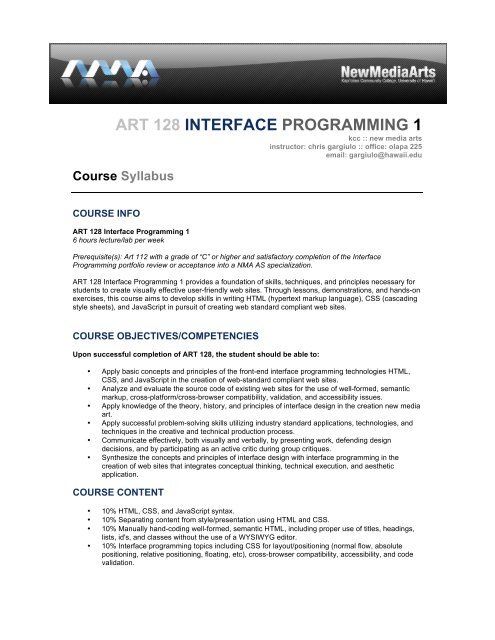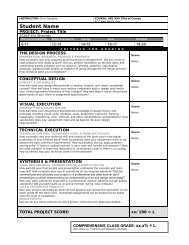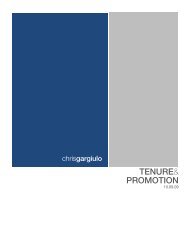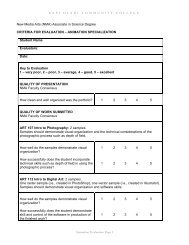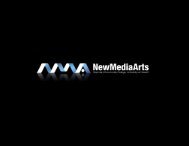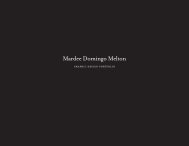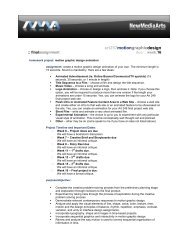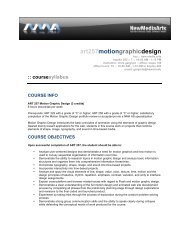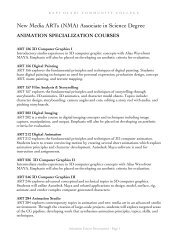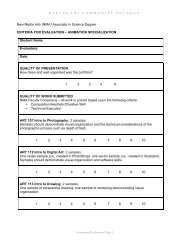View the Syllabus - KCC New Media Arts
View the Syllabus - KCC New Media Arts
View the Syllabus - KCC New Media Arts
You also want an ePaper? Increase the reach of your titles
YUMPU automatically turns print PDFs into web optimized ePapers that Google loves.
ART 128 INTERFACE PROGRAMMING 1<br />
kcc :: new media arts<br />
instructor: chris gargiulo :: office: olapa 225<br />
email: gargiulo@hawaii.edu<br />
Course <strong>Syllabus</strong><br />
COURSE INFO<br />
ART 128 Interface Programming 1<br />
6 hours lecture/lab per week<br />
Prerequisite(s): Art 112 with a grade of “C” or higher and satisfactory completion of <strong>the</strong> Interface<br />
Programming portfolio review or acceptance into a NMA AS specialization.<br />
ART 128 Interface Programming 1 provides a foundation of skills, techniques, and principles necessary for<br />
students to create visually effective user-friendly web sites. Through lessons, demonstrations, and hands-on<br />
exercises, this course aims to develop skills in writing HTML (hypertext markup language), CSS (cascading<br />
style sheets), and JavaScript in pursuit of creating web standard compliant web sites.<br />
COURSE OBJECTIVES/COMPETENCIES<br />
Upon successful completion of ART 128, <strong>the</strong> student should be able to:<br />
• Apply basic concepts and principles of <strong>the</strong> front-end interface programming technologies HTML,<br />
CSS, and JavaScript in <strong>the</strong> creation of web-standard compliant web sites.<br />
• Analyze and evaluate <strong>the</strong> source code of existing web sites for <strong>the</strong> use of well-formed, semantic<br />
markup, cross-platform/cross-browser compatibility, validation, and accessibility issues.<br />
• Apply knowledge of <strong>the</strong> <strong>the</strong>ory, history, and principles of interface design in <strong>the</strong> creation new media<br />
art.<br />
• Apply successful problem-solving skills utilizing industry standard applications, technologies, and<br />
techniques in <strong>the</strong> creative and technical production process.<br />
• Communicate effectively, both visually and verbally, by presenting work, defending design<br />
decisions, and by participating as an active critic during group critiques.<br />
• Syn<strong>the</strong>size <strong>the</strong> concepts and principles of interface design with interface programming in <strong>the</strong><br />
creation of web sites that integrates conceptual thinking, technical execution, and aes<strong>the</strong>tic<br />
application.<br />
COURSE CONTENT<br />
• 10% HTML, CSS, and JavaScript syntax.<br />
• 10% Separating content from style/presentation using HTML and CSS.<br />
• 10% Manually hand-coding well-formed, semantic HTML, including proper use of titles, headings,<br />
lists, id's, and classes without <strong>the</strong> use of a WYSIWYG editor.<br />
• 10% Interface programming topics including CSS for layout/positioning (normal flow, absolute<br />
positioning, relative positioning, floating, etc), cross-browser compatibility, accessibility, and code<br />
validation.
• 10% Interface programming techniques for common interface elements and design patterns<br />
including CSS pseudo classes (hover/rollover states), navigation and menu styles (styling lists),<br />
image replacement (IR), and controlling HTML/DHTML via Javascript/DOM scripting.<br />
• 10% Critical analysis of HTML, CSS, and JavaScript code used on contemporary Web sites.<br />
• 10% Going through <strong>the</strong> full design process of converting a visual interface design into a working,<br />
interactive interface.<br />
• 10% Quality Assurance Testing - problem-solving and troubleshooting HTML, CSS, and JavaScript<br />
by reading, understanding, and editing <strong>the</strong> code.10% Demonstrating an expanded vocabulary and<br />
an understanding of <strong>the</strong> importance of good front-end practices by presenting work, speaking about<br />
it articulately, defending coding decisions, and by participating as an active critic during group<br />
critiques.<br />
• 10% Syn<strong>the</strong>size all of <strong>the</strong> concepts and principles of front-end interface programming by creating<br />
web sites that are robust, flexible, adaptable, and easy to maintain.<br />
TEXTS<br />
There are no required texts for this course. Readings will be supplied by <strong>the</strong> instructor on a week to week<br />
basis, in ei<strong>the</strong>r paper handout form or online.<br />
Recommended, but not required, text:<br />
• HTML 5: Visual QuickStart Guide (7th Edition)<br />
by Elizabeth Castro<br />
• Designing with Web Standards. 3rd Edition. <strong>New</strong> Riders, 2009.<br />
by Jeffrey Zeldman & Ethan Marcotte.<br />
MATERIALS<br />
The primary software used in this class is Adobe Dreamweaver, which will be installed on all computers in<br />
class and in <strong>the</strong> labs. We will also use Adobe Photoshop and Illustrator.<br />
All students are required to have hosting space to post <strong>the</strong>ir designs, assignments, and ultimately <strong>the</strong>ir final<br />
web site. Students are required to purchase a hosting plan with a third party hosting provider. Past students<br />
have purchased hosting plans from Bluehost, iPage Super Green Hosting, and GoDaddy (<strong>the</strong>se are just a<br />
few of many hosting providers available). Plans should include ample disk space (ie. more than 2GB or<br />
unlimited), support for CGI, PHP, and MySQL, multiple domain hosting (to host more than one site), oneclick<br />
install/support for Wordpress, Joomla, and Drupal (popular CMS options), and a low, competitive price<br />
(an example rate is around $3-$5/month – this is subject to change based upon current trends for hosting<br />
prices).<br />
In addition to coding, students will be required to submit sketches on paper. While it is not required, it is<br />
recommended that you purchase a cheap sketchbook and a set of black and/or grayscale markers.<br />
Additional materials may include an external hard drive or thumbnail drive with a minimum capacity of 4 GB.<br />
INSTRUCTOR'S EXPECTATION:<br />
Attendance and class participation are important to succeed in this course. Lectures will be given once. It is<br />
essential that you attend class, arrive promptly and remain for <strong>the</strong> full duration of <strong>the</strong> scheduled class period.<br />
Leaving class early without permission will result in an absence marked for that class period. Consistent<br />
lateness and absences may result in a lower grade for <strong>the</strong> semester due to <strong>the</strong> missed opportunities for<br />
participation in class discussions. If you are absent for medical reasons, please provide a note from your<br />
doctor or nurse. More than five unexcused absences will result in a final grade of a F. Three tardies will<br />
equal one unexcused absence. If <strong>the</strong>re is a severe family problem, a long-term personal illness, or<br />
something else that may interfere with <strong>the</strong> course, please discuss this with me as early as possible. So long<br />
as I know about any potential problems in advance, <strong>the</strong>re is usually a solution. Please do not wait until it is<br />
too late so as to avoid any repercussions to your grade. For unexcused absences, students will need to<br />
make arrangements with o<strong>the</strong>r class members regarding missed information.
Taking notes during lectures and demonstrations is recommended. Time outside of class will need to be<br />
consistently spent on projects in order to meet <strong>the</strong> requirements of <strong>the</strong> class.<br />
There will be no email during class time! You can only check your email during class breaks.<br />
METHOD OF INSTRUCTION<br />
The method of instruction will include lectures, lessons, demonstrations, project development, individual<br />
instruction, group discussions, and critiques.<br />
METHOD OF EVALUATION & GRADING POLICY:<br />
The methods of evaluation used in this course are broken down as follows:<br />
Projects 80%<br />
Critiques 20%<br />
TOTAL 100%<br />
Students will be expected to participate as active class members. This includes attending all classes;<br />
meeting weekly, midterm, and final project deadlines; completing production time outside of class and in <strong>the</strong><br />
lab environment; and participating as dependable team members. During critiques, all students are required<br />
to participate as both presenters and critics.<br />
Grading is based on projects and participation and performance during critiques. It is <strong>the</strong> responsibility of <strong>the</strong><br />
student to collect handouts, take notes, complete and turn in assignments on due dates. Make-up<br />
assignments will be administered only in cases where <strong>the</strong>re is a valid medical reason accompanied by a<br />
doctor's note. Missing a deadline will result in a full letter grade reduction for that project unless <strong>the</strong>re is a<br />
valid medical reason or a family emergency. Projects may be revised and turned in again for re-grading.<br />
• Any student missing <strong>the</strong> mid-term/final semester critique or not turning in a midterm/final<br />
project without prior permission will have a full letter grade taken off <strong>the</strong> final semester<br />
grade.<br />
Four major components of <strong>the</strong> class total 500 points for <strong>the</strong> course grade. The 500 Points for <strong>the</strong> final course<br />
grade can be broken down as follows:<br />
500 Point Course Grading System<br />
All Grades are available throughout <strong>the</strong> semester via Laulima<br />
Site #1 (Week-by-Week, Step-by-Step Coding)<br />
• 8 Steps (25 Points each)<br />
Site #2 (Midterm)<br />
• Coded Site Due (100 Points)<br />
Site #3 (Final)<br />
• Coded Site Due (100 Points)<br />
Class Participation<br />
• Critiqes and online via Laulima<br />
200 Points 40%<br />
100 Points 20%<br />
100 Points 20%<br />
100 Points 20%<br />
TOTAL 500 Points 100%<br />
Dividing <strong>the</strong> total 500 points by 5 will yield a more legible final course letter grade, dictated as follows:<br />
A 90-100 B 80-89 C 70-79 D 60-69 F 59-0
SPECIAL STUDENT SERVICES (SSSO)<br />
Extended time in a distraction-free environment is an appropriate accommodation based on a student's<br />
disability. If you are a student with a documented disability and have not voluntarily disclosed <strong>the</strong> nature of<br />
your disability and <strong>the</strong> support you need, you are invited to contact <strong>the</strong> Disability Support Services Office,<br />
Ilima 103, 734-9552 (V/T), or email kapdss@hawaii.edu for assistance.<br />
STUDENT CONDUCT CODE<br />
A college campus is a community with specific behavior expectations designed to allow all students, faculty,<br />
and staff to flourish. Please familiarize yourself with <strong>KCC</strong>’s Student Conduct Code in <strong>the</strong> course catalog.<br />
You should know your rights and responsibilities on campus. The Student Conduct Code describes specific<br />
campus policies related to: drug and alcohol use, smoking, lethal weapons, sexual harassment and sexual<br />
assault, academic honesty, nondiscrimination, and family privacy.<br />
In all campus environments, Disruptive Behavior will not be tolerated. This means: any speech or action<br />
that (1) is disrespectful, offensive, and/or threatening; (2) interferes with <strong>the</strong> learning activities of o<strong>the</strong>r<br />
students; (3) impedes <strong>the</strong> delivery of college services; and/or (4) has a negative impact in any learning<br />
environment.<br />
THIS CLASS IS A “SAFE ZONE”<br />
Discriminatory or rude comments of any kind, particularly regarding gender, ethnicity, sexual orientation, or<br />
religion, will not be tolerated.<br />
SCHEDULE<br />
Throughout <strong>the</strong> semester we will be covering a variety of interface programming topics and principles.<br />
Topics will include:<br />
• Overview of software (Adobe Dreamweaver)<br />
• The full web design process<br />
• Simple mark-up language and its advantages<br />
• Ordered, unordered, and in-line lists<br />
• An introduction to XHTML & CSS<br />
• Div’s as block level elements<br />
• Normal flow<br />
• Absolute & relative positioning<br />
• image rollovers<br />
• image replacement techniques<br />
• javascript show/hide layers<br />
Week-by-week schedule:<br />
• Week 1: Intro to <strong>the</strong> Course<br />
• Week 2: HTML & CSS<br />
• Week 3: CSS Positioning<br />
• Week 4: Lists & Navigation<br />
• Week 5: CSS Hover<br />
• Week 6: CSS Image Replacement Techniques<br />
• Week 7: Sprites<br />
• Week 8: Photoshop to HTML/CSS<br />
• Weeks 9-11: Mid-term Project<br />
• Week 12: NO CLASS - SPRING BREAK<br />
• Weeks 13-17: Final Project
OFFICE HOURS<br />
Office hours are held in <strong>the</strong> computer labs, not at my office. They are operated on a first-some-first-served<br />
basis and organized via a sign-up sheet on <strong>the</strong> whiteboard in class.<br />
This semester my office hours are:<br />
• Thursdays 4:15-6:15pm in Kopiko 202<br />
EMERGENCY CONTACT<br />
In <strong>the</strong> case of an emergency or if you are unable to get a hold of <strong>the</strong> instructor and have already tried<br />
contacting Chris via phone (808-734-9707) and email (gargiulo@hawaii.edu), you can next contact <strong>the</strong> <strong>Arts</strong><br />
& Humanties department chair, Colette Higgins, by phone (808-734-9282) or email (chiggins@hawaii.edu).


